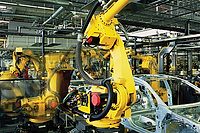UV-Curing Technology Continues to Shed Light on Assembly Techniques


The economic savings, process optimization and increased product performance of UV materials at first were limited to large-volume producers who could tolerate the initial monetary investments incurred to justify the benefits. However, dramatic developments in raw materials, improvements in photo-initiators and decreases in cost of UV-curing equipment have made UV-curable techniques more accessible to smaller companies. UV and broad-spectrum light-curing resins can reduce costs for many assembly processes.
Originally developed for inks and thin coatings, light curing did not become popular for other applications until the early 1980s. Light curing has since become the method of choice for many bonding, sealing, coating, potting and tacking applications. Because faster cures boost process efficiency and lower total assembly cost, and because light-curing adhesives are being used in a wider variety of applications, the types of resins and curing equipment available have expanded dramatically.

A Wider Variety of Applications
Some applications that employ UV-curing adhesives include glass and most plastics bonding, medical disposable-device assembly, military and consumer electronics, microelectronics and optical encapsulation, lens assembly, conformal and decorative coatings, strain-relief, and gasketing in automotive and consumer-product assemblies. Today's opportunities for light-curing resins are limited only by the ability of the resin to be exposed to and polymerized by light.Manufacturers need to make sure that the adhesive, coating or encapsulant matches the "life" requirements of the particular assembly. The next step is to match the spectral output of the lamp with the adhesive's curing chemistry.
For example, most coatings and UV inks require very fast, dry cures -- typically run rates of 50 to 150 fpm -- to be economically practical and are formulated to cure at very high speeds in thin layers. These coatings exhibit good adhesion to porous surfaces, like paper, and curing requires high-intensity lamps mounted on wide conveyors. It is critical that these lamps emit high doses of short-wavelength UV light to cure these formulations.
Unlike UV inks and thin-layered coatings, most high-strength bonding, coating, tacking and potting applications require depths of cure from 0.003 to 0.25 inch, moderate- or high-intensity lamps with broad-spectrum curing capability and concentrations in the long wave and visible spectrum. Cure speeds with these resins and lamps are far slower than for typical ink or coating applications. However, the 1- to 15-fpm process rates or 1- to 30-second exposure times needed to achieve cures are generally faster than those of other resins.

Categorize Equipment by Its Footprint
Most curing equipment can be categorized by the shape or footprint of the light that is produced where cure takes place. On the basis of shape, light can be categorized into spot, beam and flood configurations. Spot lamps can be divided into those that produce a 1- to 2.5-inch spot or medium to low intensity (10 to 100 mW/cm2) as is produced by so-called "black" lights used in non-destructive testing (NDT). Higher-intensity, 1- to 10-W (1,000 to 10,000 mW/cm2) wand-style spot systems have become very popular and are very useful wherever small spots of adhesive need to be cured (Figure 1).When selecting a high-intensity spot-cure system, inquire of the manufacturers the true intensity of the system as a specific "window" of the spectrum required to photo-initiate the material you are working with. Unfortunately, some manufacturers claim their systems are capable of producing very high intensity. What is not being said is that their curing intensity comprises a combination of short wave, long wave and visible light, not necessarily all required to cure the material you have selected.
Flood lamps usually provide low- to moderate-intensity light (Figure 2). These lamps have the advantage of being able to cure parts in batches, or parts with large bonded or coated areas. Manufacturers commonly use these kinds of lights mounted over indexing tables or conveyors. Deep cures can be achieved by using these relatively inexpensive units in 10- to 30-second exposures. Large-area flood lamps are used to cure substrates that are somewhat heat-sensitive, including certain plastics.
Generally speaking, the higher the intensity, the faster the cure, although a situation of diminishing returns is rapidly reached for intensities above 2,000 mW/cm2. One of the advantages of UV curing is that many resins are so sensitive that they cure at intensities far lower than those emitted by many UV lamps.
Quality Assurance Is Essential
After determining the correct adhesive or sealant and most appropriate curing system for an application, determine the speed required for the process. Then determine the minimum amount of light intensity required to achieve cure in the time permitted at the selected speed or exposure time. A periodic radiometer reading at the bond line is a cost-effective method of checking the effective lamp intensity of the curing system. This quality-assurance exercise is essential because the intensity of most UV-emitting lamps decreases over time.Therefore, to maintain a practical lamp life, manufacturers should choose a lamp in which intensity at half its initial rating provides more than two times the intensity required for cure. Fortunately, there are many UV-curing lamps that emit 10 to 100 times the minimum intensity needed to cure most UV-curable formulations. Higher cost, high-intensity, electrodeless UV lamps avoid the issue of lamp-intensity degradation. This type of lamp yields long lamp life and shutoff when intensity drops to a preset level.
Generally, lamp-dose energy required for cure is not a useful indicator of a complete cure because it does not ensure 100% integrity of the bonded part. Inline testing yields immediate and consistent quality assurance. One of the conveniences of UV processing is the ease of incorporating 100% inline inspection or bond testing (Figure 3). Due to the instant-curing characteristics of the adhesive, simple mechanical tests are frequently done inline as soon as the curing process has taken place. Costly and cumbersome offline processes can be eliminated.
There are applications in which photo curing may not be the correct choice. For example, if the assembly or process blocks the resin from exposure to light, UV-curable adhesives are not the best choice. However, some UV-curable resins have secondary curing mechanisms. UV catalysts have long been combined with activator and heat-curing systems in resins.
More recently, UV-curable resins have been developed as two-part systems and as systems that are also sensitive to curing upon exposure to oxygen and moisture. Usually, these systems are only practical when UV curing is the primary curing mechanism and the majority of the resin is light-cured.
Another exception is that of UV epoxies that continue to cure following exposure to light. This is known as "dark cure." The light starts a chain reaction that can continue, regardless of circumstances, until cure is complete. Unfortunately, applications for this type of adhesive are limited, and cure times may be difficult to predict.
Because of processing and performance advantages of UV formulations, a rapidly growing industry of service, equipment and resin providers has arisen. The number and types of applications where resins have been used successfully have provided the impetus for this growth. As competition intensifies, this technology can be expected to continue to grow and diversify.
Additional information on ELC UV Light Systems is available from Electro-Lite Corp., 43 Miry Brook Road, Danbury, CT 06810-7414; call 203-743-4059; fax 203-792-2275; e-mail eluv@electro-lite.com; or visit www.electro-lite.com. Or Circle No. 71.
Links
Looking for a reprint of this article?
From high-res PDFs to custom plaques, order your copy today!




